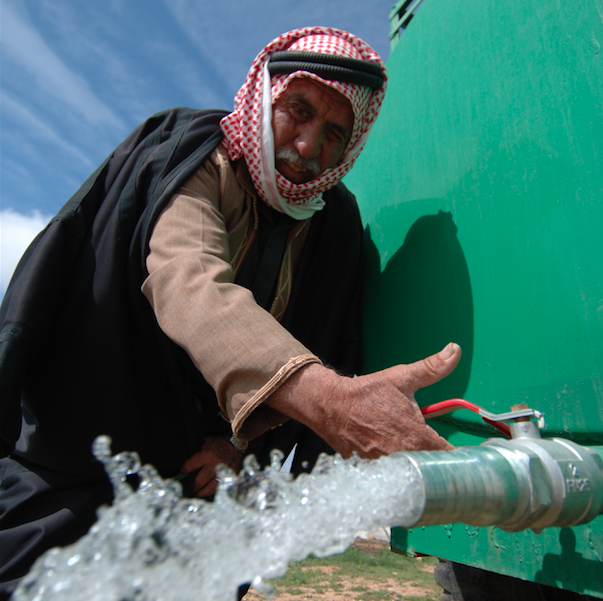
By Christian Holmes, USAID Global Water Coordinator
We are extremely gratified that the Senator Paul Simon Water for the World Act passed both houses of Congress unanimously and was signed into law by President Obama on December 19, 2014. In addition to helping address the needs of the 2.5 billion people who do not have access to sanitation and the 750 million people who live without safe drinking water, the Water for the World Act emphasizes that those services need to be sustainable.
The focus on providing sustainable safe drinking water, sanitation, and hygiene (WASH), central to both the Water for the World Act and the USAID Water and Development Strategy, is vital. Up to 40 percent of rural water systems fail prematurely, and less than one percent of WASH projects have long-term monitoring.
Understanding what we mean by WASH sustainability requires a distinction between the physical infrastructure – pipes and pumps – and the services they provide. Water service is the flow of water with certain quantity, quality, and continuity characteristics, while sustainable water service is the maintenance of that flow of water over time. Sustainability of WASH services is achieved when host country partners and communities on the ground are empowered to take ownership of the development processes, and when the local systems are in place to deliver the inputs and resources needed to maintain results and deliver impacts beyond the life of external donor support.
The evidence of service failure along with an increased drive for aid effectiveness has resulted in increased research, analysis, and thinking around sustainability of WASH services over the last few years. The Dutch Government triggered the global movement to ensure sustainable services following a 2012 study of its WASH programs, which highlighted that despite “…numerous references to sustainable development, policies and programs are still oriented too much towards short-term delivery of physical infrastructure and institutions, partially driven by the emphasis on visible short-term results and by spending pressure. The need for institutional maintenance of services… is insufficiently recognized.” This has reinforced what we know to be true: In rural settings in particular, donor and NGO interventions too often fail after the external partner leaves the scene.
Under our Water Strategy, we commit to an overarching Strategic Objective: Improve health outcomes through the provision of sustainable safe water, sanitation, and hygiene. This commitment gives us a mandate to look at different ways of thinking about and designing our WASH programming to be directly attentive to sustainability issues. In 2012, USAID joined the steering committee for the Sanitation and Water for All (SWA) global partnership. Through this global platform, we join with host countries and other development partners to harmonize our efforts toward development effectiveness and to work together toward achieving first the MDGs and, soon, the Sustainable Development Goals for WASH services. At the SWA High Level Meeting in 2012, Administrator Shah committed to an Agency investment in the knowledge around sustainable service provision, a commitment that we are now working to operationalize.
USAID’s Water Office is currently working to develop a suite of tools to help Missions apply global, Agency, and Congressional best practice sustainability requirements to its WASH programming. The ultimate responsibility for service sustainability rests with local stakeholders and government, so our guidance and resources will be rooted in local systems and will take into account primary factors that affect sustainability: technical, environmental, financial, social, and institutional/governance. By deliberately structuring analysis, planning, design, implementation, and monitoring with regard to these factors, there is greater potential that our programming will achieve sustained delivery of WASH services in the countries where we partner. We need to recognize that this approach, as an alternative to just providing hardware, will take more thought and more time and resources, but provides a better development outcome and averts the need for constant reinvestment in WASH systems when they fail.
The Strategy also calls for the Agency to make longer-term investments in monitoring and evaluation of water activities in order to assess sustainability beyond the typical USAID program cycle and to enable reasonable support to issues that arise subsequent to project implementation. This is an important way for us to know when we have been successful in our drive to foster environments for sustained service. Here again, we need to be mindful not just of our own monitoring and reporting needs, but of the need for governments and local stakeholders to have ownership of these monitoring systems. And we need to design our interventions to build local capacity to monitor, evaluate, research, and learn.
We are currently developing methodology to look at whether the systems around WASH services are functioning. We are also trying to understand how best to benchmark and track those systems.
It’s time to think of sustainable WASH services at scale. If we tailor our approach and work with our global and local partners to think long term and big picture, we can achieve real sustainability of WASH services and tangible and effective development outcomes.







Comment
Make a general inquiry or suggest an improvement.